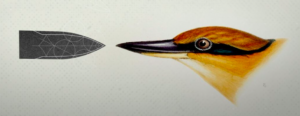One of the most notable examples of how biomimicry can be used in engineer ing design and innovation is Japan’s Shinkansen Bullet Train. In 1989, Japan’s “fastest and most convenient” train system identified a problem that could not be ignored [1]. When exiting a tunnel with speeds pushing 170 mph, the Shinkansen Bullet Trains generated a disruptive sonic boom. This explosive noise caused issues everywhere, especially in residential areas. The train company was forced to bring in an engineering team to design a quieter train that was just as powerful. Luckily for the environment and society, the general manager of the Technical Development Department, Eiji Nakatsu, was a passionate birdwatcher. Knowing that noise disruption was the main problem his team was assigned, Nakatsu thought of various bird species and their specialized techniques to limit noise and maximize energy.
ing design and innovation is Japan’s Shinkansen Bullet Train. In 1989, Japan’s “fastest and most convenient” train system identified a problem that could not be ignored [1]. When exiting a tunnel with speeds pushing 170 mph, the Shinkansen Bullet Trains generated a disruptive sonic boom. This explosive noise caused issues everywhere, especially in residential areas. The train company was forced to bring in an engineering team to design a quieter train that was just as powerful. Luckily for the environment and society, the general manager of the Technical Development Department, Eiji Nakatsu, was a passionate birdwatcher. Knowing that noise disruption was the main problem his team was assigned, Nakatsu thought of various bird species and their specialized techniques to limit noise and maximize energy.
Eiji Nakatsu alongside bullet train
After reviewing the biology of birds, his team developed an improved train design with the “wings of an owl, the belly of a penguin, and the nose of the kingfisher” [3]. The kingfisher’s beak, which allows it to dive into water to catch its prey with virtually no noise, had the greatest influence over the new design. Owls’ feathers which allow the birds to swoop down silently to catch prey, informed the design of the pantograph- the rig that connects the train to the electrical wires above. The Adélie penguin’s belly, which allows the penguin to gracefully glide across the ground surface, influenced the pantograph’s support shaft to reduce friction and drag. This new bullet train design, which debuted in 1997, was much quieter (staying under the 70 decimal noise limit in residential areas) and energy-efficient (being 10% faster while using 15% electricity). By removing the artificial barrier between biology and innovation, these engineers were able to mimic natural techniques to address a human problem and improve the solution.
References:
- “Shinkansen: The Japanese bullet trains” webpage accessed through jrailpass.com: https://www.jrailpass.com/shinkansen-bullet-trains
- “Biomimicry: How Designers Are Learning from the Natural World” (2017) article by 99% invisible: https://99percentinvisible.org/article/biomimicry-designers-learning-natural-world/
- “The world is poorly designed. But copying nature helps.” (2017) YouTube video by Vox: https://youtu.be/iMtXqTmfta0
- https://www.vox.com/videos/2017/11/9/16628106/biomimicry-design-nature [image]